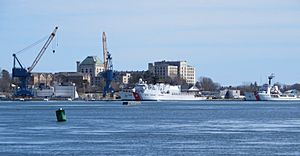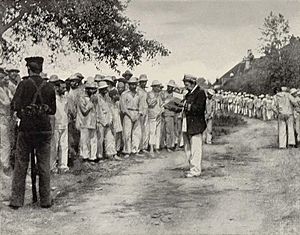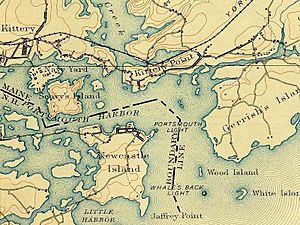Seavey's Island facts for kids

Seavey's Island is a special piece of land in the Piscataqua River. It is located in Kittery, Maine, right across from Portsmouth, New Hampshire. This island is home to the Portsmouth Naval Shipyard, a very important place where ships are built and repaired. Seavey's Island covers about 278 acres, which is like 210 football fields!
Contents
The Story of Seavey's Island
How One Island Became Five
Seavey's Island wasn't always one big island. It used to be five smaller islands! Early settlers used these rocky islands to gather wild berries. They also dried fish on special racks called fish flakes.
In 1800, the U.S. government wanted to create its first federal shipyard. Secretary of the Navy Benjamin Stoddert bought Fernald's Island for $5,500. This island was also known as Dennett's Island. Later, in 1866, the largest island, Seavey's Island, was added. This is how the group of islands got its current name.
Over time, other islands like Clark's and Jamaica Island were also connected to Seavey's. This made one large area for the shipyard.
Building a Giant Drydock
In 1900, the Congress approved a big project. Workers built a huge granite drydock that was 750 feet long. A drydock is like a giant bathtub for ships. It can be drained of water so workers can fix the parts of a ship that are usually underwater. This drydock was built in the space that used to separate Fernald's and Seavey's islands.

Protecting the Harbor
On the southern part of Seavey's Island, there was once a defense called Fort Sullivan. It was built in 1775 to help protect Portsmouth Harbor. This fort worked with Fort William and Mary and Fort McClary during the American Revolution and the War of 1812. After 1815, the fort was not used for a while. It was used again during the American Civil War from 1861 to 1865. It had 11 large cannons to defend the area.
Making Way for Ships
Another defense was on Henderson's Point, to the west. But this point stuck out 540 feet into the Piscataqua River. This made it hard for large warships to reach the navy yard. So, on July 22, 1905, engineers decided to remove it. They used a huge amount of dynamite in what was then the biggest explosion ever attempted!
First, they built a special wall called a cofferdam. Behind it, they dug out a lot of rock and soil. Then, they set off the explosives. Debris flew 170 feet into the air! In just a few seconds, the river became 350 feet wider. This made it much easier for ships to move around.
A Place for Prisoners

In 1908, the Portsmouth Naval Prison was finished on the southern side of Seavey's Island. Before the prison, this spot was a camp called Camp Long. In 1898, during the Spanish–American War, 1,612 prisoners of war from the Battle of Santiago de Cuba were held there.
Another camp, Camp Heywood, was located just north of the prison. It was a camp for Marines. Today, the Portsmouth Naval Shipyard has 62 buildings that are listed on the National Register of Historic Places. This means they are important historical sites.
A Border Battle
In 2001, there was a disagreement between New Hampshire and Maine about Seavey's Island. New Hampshire said the island should be part of their state. Maine disagreed. The case went all the way to the Supreme Court. The Supreme Court decided that Maine had the right to the island.
Places to Visit
- Portsmouth Naval Shipyard Museum (Building 31)


